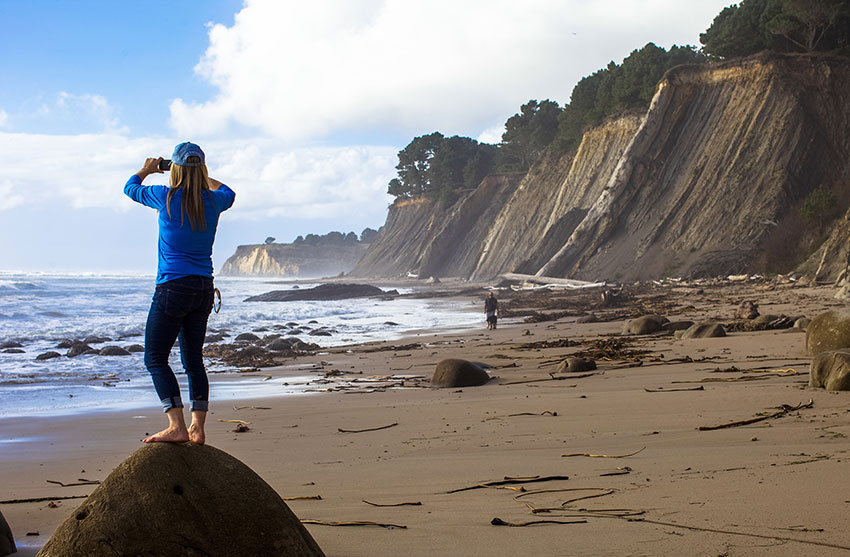FOR IMMEDIATE RELEASE
Dec. 29, 2015
Contacts:
Sarah Marquis, 949-222-2212
New NOAA report highlights economic impact of recreation in North Central California national marine sanctuaries

Visitors in Greater Farallones and the northern portion of Monterey Bay national marine sanctuaries spent $127 million for non-consumptive recreation activities, those that do not include removal of marine resources, and supported nearly 1,700 jobs in 2011, according to a NOAA report released today.
Using data collected by the state of California in 2011, this report provides new insight into the types of recreational activities enjoyed in national marine sanctuaries located along the North Central Coast (NCC) of California, from Alder Creek in the north to Pigeon Point in the south. The data, collected from 13 counties in the NCC region, covered all recreation uses but was primarily focused on activities that did not extract resources, such as diving, beachgoing and bird watching. In June, NOAA released a report that analyzed the economic impacts of recreational fishing in California’s national marine sanctuaries.
Collectively, an estimated 4.17 million visitors engaged in recreation in the NCC region, including 438,000 visitors in Greater Farallones and the northern portion of Monterey Bay national marine sanctuaries. On average, each of these visitors made roughly five trips per year.
Respondents reported participating in more than 20 different recreational activities in the two sanctuaries, including sightseeing, water sports and diving. The top five most popular activities among survey respondents were beach going, coastal scene watching from a car, sightseeing, photography and bird watching.
“Coastal recreation generates significant economic revenues to coastal economies,” said Bob Leeworthy, NOAA’s Office of National Marine Sanctuaries chief economist. “This report underscores the value of national marine sanctuaries as focal points for non-consumptive forms of recreation and local economic development in California’s North Central Coast.”
The peer-reviewed report, A Socioeconomic Profile of Recreation Users of the California Northern Central Coast Region, Greater Farallones National Marine Sanctuary and the Northern Portion of Monterey Bay National Marine Sanctuary, 2011 was produced by the Office of National Marine Sanctuaries’ Socioeconomics Research and Monitoring Program.
Among the findings:
- Non-consumptive recreation accounted for 98.7 percent of all recreation in the Northern Central Coast region, including 86.7 percent in Greater Farallones National Marine Sanctuary and 95 percent in the northern portion of Monterey Bay National Marine Sanctuary.
- Recreation in Greater Farallones and northern Monterey Bay, on average, generated an additional $80 million in income to business owners and employees.
- In Greater Farallones, surface water sports, including kayaking, kite, wind and body surfing, swimming and boating, followed by sightseeing, were the top two reported recreation activities among survey respondents.
- In the northern portion of Monterey Bay, sightseeing and beachgoing were the top two recreation activities.
- Total spending for non-consumptive recreation was estimated at $1.15 billion in 2011 for the entire NCC Region. Roughly 11 percent of the total spending took place in the two sanctuaries – $86.25 million in Greater Farallones and $40.82 million in the northern portion of Monterey Bay.
- On average, visitors participating in non-consumptive recreation in the entire NCC Region spent $31.14 per day, while those that did the activities in Greater Farallones spent $31.48 and those in the northern portion of Monterey Bay spent $26.68.
- Food, beverage and lodging accounted for 80.3 percent of spending in the NCC Region, 71.6 percent in Greater Farallones and 65.7 percent in the northern portion of Monterey Bay.
The complete recreational economic impacts study, along with earlier national marine sanctuary socioeconomic reports, can be found here.
NOAA’s Office of National Marine Sanctuaries serves as trustee for a network of underwater parks encompassing more than 170,000 square miles of marine and Great Lakes waters. Through active research, management, and public engagement, national marine sanctuaries sustain healthy environments that are the foundation for thriving communities and stable economies.
NOAA's mission is to understand and predict changes in the Earth's environment, from the depths of the ocean to the surface of the sun, and to conserve and manage our coastal and marine resources. Join us on Facebook, Twitter, Instagram and our other social media channels.

